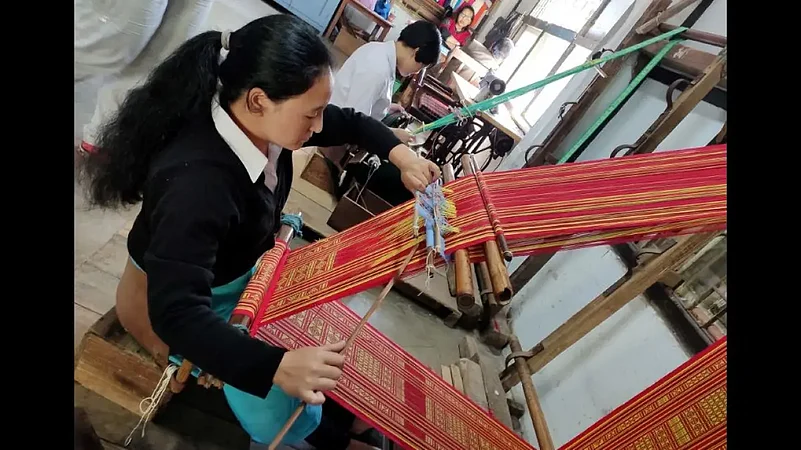Unless you have been living under a rock, you would know that the environmental impact of the clothes we buy extends far beyond our homes, to the soil, and oceans (micro fibres have been found in not just fish, but also plankton). More reason then that communities around the world are trying to make sure their consumption patterns are less damaging. Slow or sutainable fashion, as opposed to mass churning out of products by brands, is on the rise. People are increasingly finding ways to take climate action and reduce their environmental impact through their buying choices. In such a scenario, it makes sense to focus on forgotten traditional handlooms, textiles, and crafts. And India is a country that has a wealth of these. However, many are under severe stress or dying out due to economic pressures. Demonetisation and GST have had a huge negative impact on our traditional crafts which are all based out of rural areas. Also, the next generation of craftspersons are thinning out as the young in artisan families are just not keen to get into a profession that many view as financially unrewarding.??
Why You Must Pick Up A Loinloom Jacket From This Place In Gangtok
The state handicraft centre has to be on your bucketlist when you are in Sikkim

Which is why it is a pleasant revelation when you come across a place that not only showcases and sells handicrafts, but also teaches young people how to make them. The Directorate of Handicrafts and Handloom (DHH) in Gangtok, located at Zero Point, is the best place to shop for handloom and handicraft items produced in the state. Your Gangtok trip should definitely include a visit to this green-hued, multi-storeyed building to pick up handcrafted gifts, and also to observe how they are made.
Established in 1957, DHH is essentially a training-cum-production hub, which promotes and helps nurture Sikkim’s traditional arts and crafts.Sikkim is home to the Lepchas, Bhutias, and Tsongs, communities with a rich tradition of crafts.
At the DHH training centre, you will come across people creating thanka paintings, handwoven and handknotted woollen carpets, handcarved furniture, handlooms and many other items. The training centre is housed in one building and the shop in another. At the training rooms, you will come across young people hard at work, picking up the rudiments of painting, carving and weaving. They even have a room that has been designated as a museum, showcasing crafts of the state.?Apart from old masks, thankas, woven textiles and wood carvings, you?will also find an ancient beehive on display here.? ?

At the shop, you can pick up a range of local handicrafts and textiles. One of their most popular products are the wood-carved home decor items which include choktses (carved, small tables which can be folded easily and carted around), bakchoks (square tables), wooden masks, screens, lucky signs, lamp stands, and decorative items with traditional designs like dragons, birds, and phoenix. They also stock bags and cushions made with the typical Sikkim silk fabrics.?
What really stands out here are the traditional handlooms – bags, jackets and even belts woven with geometric patterns. Many decades back, yarn spun out of stinging nettle (sisnu) was used for weaving. Lepcha families used to?have their own loom in their house with frames made of bamboo. And the clothes they would wear were made on this loom.?
When weaving, cotton yarn is wound in wooden frames (according to specified length and breadth) and fitted in a vertical loom. Traditional ones are known as the loinloom (used across the northeast) due to the fact that it is placed on the weaver's lap and used. The DHH has applied for the Geographical Indications (GI) registration of this art.
The cloth woven at the centre gets crafted into bags, belts, shawls, house linen, jackets, caps, and traditional dresses. These are available at their shop.?
DHH has over 20 training-cum-production?centers in Sikkim.?It is heartening to see Sikkimese youth inside their training rooms, learning how to weave intricate geometric patterns into textiles, carving instricate designs on wood, and carefully executing minute brush strokes on thanka paintings. Traditional craft skills are part of our cultural heritage, and they have to be passed on to the next generation. So do visit the DHH and the training rooms. And pick up a thanks, a choktse or a loinloom belt, or jacket. You will be helping safeguard a living cultural tradition.?
The Information
Address:?Zero Point, NH 31 A, Gangtok, Sikkim 737101.
Timings: Monday to Saturday. 10am to 4:20pm. They have a one hour lunch break around 1pm.
Entry: Rs 15 for adults. Children below 12 get free entry.
-
Previous Story
 Tom Holland Recalls ‘Trip Of A Lifetime' Visiting India With Girlfriend Zendaya
Tom Holland Recalls ‘Trip Of A Lifetime' Visiting India With Girlfriend Zendaya - Next Story


















